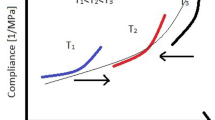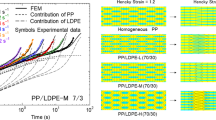Abstract
Transient elongational rheology of two commercial-grade polypropylene (PP) and the organoclay thermoplastic nanocomposites is investigated. A specifically designed fixture consisting of two drums (SER Universal Testing Platform) mounted on a TA Instruments ARES rotational rheometer was used to measure the transient uniaxial extensional viscosity of both polypropylene and nanoclay/PP melts. The Hencky strain rate was varied from 0.001 to 2 s − 1, and the temperature was fixed at 180°C. The measurements show that the steady-state elongational viscosity was reached at the measured Hencky strains for the polymer and for the nanocomposites. The addition of nanoclay particles to the polymer melt was found to increase the elongation viscosity principally at low strain rates. For example, at a deformation rate of 0.3 s − 1, the steady-state elongation viscosity for polypropylene was 1.4 × 104 Pa s which was raised to 2.8 × 104 and 4.5 × 104 Pa s after addition of 0.5 and 1.5 vol.% nanoclay, respectively. A mesoscopic rheological model originally developed to predict the motion of ellipsoid particles in viscoelastic media was modified based on the recent developments by Eslami and Grmela (Rheol Acta 47:399–415, 2008) to take into account the polymer chain reptation. We show that the orientation states of the particles and the rheological behavior of the layered particles/thermoplastic hybrids can be quantitatively explained by the proposed model.




















Similar content being viewed by others
References
Advani SG, Tucker CL (1987) The use of tensors to describe and predict fiber orientation in short fiber composites. J Rheol 31:751
Advani SG, Tucker CL (1990) Closure approximations for three-dimensional structure tensors. J Rheol 34:367
Bird RB, DeAguiar JR (1983) An encapsulated dumbell model for concentrated polymer solutions and melts I. Theoretical development and constitutive equation. J Non-Newton Fluid Mech 13:149
Bird RB, Dotson PJ, Johnson NL (1980) Polymer solution rheology based on a freely extensible bead-spring chain model. J Non-Newton Fluid Mech 7:213
Bird RB, Armstrong RC, Hassager O (1987a) Dynamics of polymeric liquids, vol 1, 2nd edn. John Wiley, New York
Bird RB, Hassager O, Armstrong RC, Curtis CL (1987b) Dynamics of polymeric liquids, vol 2, 2nd edn. Wiley, New York
Cintra JS, Tucker CL (1995) Orthotropic closure approximations for flow-induced fiber orientation. J Rheol 39:1095
Eslami H, Grmela M (2008) Mesoscopic formulation of reptation. Rheol Acta 47:399–415
Eslami H, Grmela M, Bousmina M (2009) A mesoscopic tube model of polymer/layered silicate nanocomposites. Rheol Acta 48:317–331
Folgar FP, Tucker CL (1984) Orientation behaviour of fibers in concentrated suspensions. J Reinf Plast Compos 3:98
Galgali G, Ramesh C, Lele A (2001) A rheological study on the kinetics of hybrid formation in polypropylene nanocomposites. Macromolecules 34:852
Giannelis EP, Krishnamoorti R, Manias E (1999) Polymer–silicate nanocomposites: model systems for confined polymers and polymer brushes. Adv Polym Sci 138:10
Grmela M (1985) Stress tensor in generalized hydrodynamics. Phys Lett A 111:41
Grmela M, Ottinger HC (1997) Dynamics and thermodynamics of complex fluids I. Development of a GENERIC formulation. Phys Rev E 55:6620
Jeffery GB (1922) The motion of ellipsoidal particles immersed in a viscous fluid. Proc R Soc Lond A, 102:161
Letwimolnum W, Vergnes B, Ausias G, Carreau PJ (2007) Stress overshoots of organoclay nanocomposites in transient shear flow. J Non-Newton Fluid Mech 141:167
Lin-Gibson S, Kim H, Schmidt G, Han CC, Hobbie EK (2004) Shear-induced structure in polymer–clay nanocomposite solutions. J Colloid Interface Sci 274:515
Onsager L (1949) The effects of shape on the interaction of colloidal particles. Ann N Y Acad Sci 51:627
Ottinger HC, Grmela M (1997) Dynamics and thermodynamics of complex fluids II. Illustrations of a general formalism. Phys Rev E 55:6633
Rajabian M, Dubois C, Grmela M (2005) Suspensions of semiflexible fibers in polymeric fluids: rheology and thermodynamics. Rheol Acta 44:521
Rajabian M, Naderi G, Beheshty MH, Lafleur PG, Dubois C, Carreau PJ (2008a) Experimental study and modeling of flow behavior and orientation kinetics of layered silicate/polypropylene nanocomposites in start-up of shear flows. Int Polym Process 13:110
Rajabian M, Dubois C, Grmela M, Carreau PJ (2008b) Effects of polymer–fiber interactions on rheology and flow behavior of suspensions of semiflexible fibers in polymeric liquids. Rheol Acta 47:701–71
Ren J, Casanueva BF, Mitchell CA, Krishnamoorti R (2003) Disorientation kinetics of aligned polymer layered silicate nanocomposites. Macromolecules 36:4188
Sentmanat M, Wang BN, McKinley G (2005) Measuring the transient extensional rheology of polyethylene melts using the SER universal testing platform. J Rheol 49:585
Solomon MJ, Almusallam AS, Seefeldt KF, Somwangthanaroj A, Varadan P (2001) Rheology of polypropylene/clay hybrid materials. Macromolecules 34:1864
Werveyst B (1998) Numerical predictions of flow-induced fiber orientation in three dimensional geometries. PhD Thesis, Department of Mechanical and Industrial Engineering, University of Illinois at Urbana-Champaign
Author information
Authors and Affiliations
Corresponding author
Rights and permissions
About this article
Cite this article
Rajabian, M., Naderi, G., Dubois, C. et al. Measurements and model predictions of transient elongational rheology of polymeric nanocomposites. Rheol Acta 49, 105–118 (2010). https://doi.org/10.1007/s00397-009-0395-3
Received:
Accepted:
Published:
Issue Date:
DOI: https://doi.org/10.1007/s00397-009-0395-3




